Abstract
As major carbon (C) pools in cities, urban green spaces play a crucial role in reducing atmospheric carbon. To determine the importance of litterfall C storage in urban green spaces, we selected the leaf area index (LAI) as a proxy indicator for litterfall C density (LCD), and established a log-linear regression model between LCD and LAI to predict the annual litterfall C pool in large-scale urban green spaces using Sentinel-2 satellite remote sensing data. Forty-five sample units were randomly selected in typical urban green spaces in Beijing, China. A high-temperature combustion method was used to measure the LCD of the sampling units, and stepwise linear regression was used to filter the proxy indicator for LCD. The annual litterfall C pool in regions within the Fifth Ring Road was also estimated with inversion using remote sensing data. From 2015 to 2021, the estimated annual litterfall C pool was in the range of 4.5–5.8 × 1010 g, i.e., approximately 18.9% of the total C storage recorded for the urban green space, which was far greater than that observed in forest ecosystems. We concluded that the litterfall C pool in urban green spaces is seriously underestimated, and that urban tree litterfall has the potential to reduce greenhouse gas emissions if used as a carbon-neutral resource.
1. Introduction
The rapid growth of cities and the increasing threat of global warming have significantly impacted the development of urban ecological systems [1]. In 2020, China committed to the goals of carbon peaking and achieving carbon neutrality [2]. The pursuit of these goals has resulted in accelerated measures to reduce carbon (C) emissions. As a megacity, Beijing has taken the lead in promoting the concept of development with reduced material inputs and is actively promoting the construction of a green city. In October 2022, the Beijing Municipal People’s Government issued the Implementation Plan for a Carbon Peak in Beijing, which clearly states that enhancing the C storage of the urban ecosystem and promoting urban green space to enhance C storage will be crucial to achieving peak carbon.
In the urban area of Beijing, urban green spaces serve as the primary vegetation for C pools. Such spaces play a pivotal role in regulating the carbon and oxygen balance of the city by directly increasing C storage and indirectly reducing C emissions [3]. Strengthening the management and green utilization of litterfall are cost-effective approaches to enhancing C storage in urban green spaces, in addition to measures such as increasing the area of green cover [4], planting native tree species with high C storage potential [5], and optimizing plant community configuration [6]. To emphasize the significance of the litterfall C pool in reducing C emissions in urban areas, we developed a rapid, accurate litterfall C pool estimation method, and applied it to assess the annual litterfall C pool in large urban green spaces using remote sensing data.
Previous studies of the size of the litterfall C pool have mainly focused on forest ecosystems. Turner et al. [7] reported that the soil C pool accounts for 50% of total timberland C; whereas the tree C pool, including coarse roots, accounts for 33%; woody debris accounts for 10%; and the forest floor and understory account for 7%. Therefore, the litterfall C pool is almost one quarter of the living tree C pool. Due to the accumulation and subsequent decomposition of litterfall in forest ecosystems, most litter-sequestered C is re-released, and the actual carbon stocking capability of litterfall may be severely underestimated. However, in urban green spaces, litterfall is regularly gathered due to hygiene concerns and fire risks. Gathering litterfall significantly reduces the release of carbon dioxide (CO2) through on-site decomposition [8]. Biogas produced from fallen leaves can reduce fossil fuel consumption [9]. The utilization of gathered litterfall as a carbon-neutral resource, therefore, has the potential to reduce greenhouse gas emissions [10]. Current methods for exploiting urban green waste, both domestically and internationally, include pelletization [11], composting [12], biomass charcoal manufacturing [13,14], and green mulch [15,16,17]. Litterfall gathering could, therefore, provide the foundation for fully achieving the carbon stocking potential of litterfall.
Previous studies of forest litterfall C storage have primarily focused on mechanistic explanations of the impacts of litterfall on soil organic C solidification [18,19] and on the transfer of nutrients such as nitrogen and phosphorus [20,21]. There are significant correlations between litterfall types, microbial efficiency, and soil organic carbon (SOC) [22]. The carbon-to-nitrogen ratio of litterfall at a large spatial scale significantly impacts the SOC in subtropical forests [23]. Moreover, litterfall is a critical component of carbon and nutrient cycling [24], and is the primary vehicle for transferring inorganic and organic nutrients from vegetation to soil [25]. However, few studies have investigated the C stocking capability of litterfall from urban trees [26].
In this study, we hypothesized that the annual litterfall C pool in urban green spaces was larger than that measured in forest ecosystems under conditions in which litterfall is gathered and used as a carbon-neutral resource, with litterfall receiving the attention of policy makers for its potential to reduce C emissions. The specific objectives of this study were to establish a rapid, accurate model to estimate litterfall C storage in urban green spaces by selecting easily measured proxy indicators; to estimate the annual litterfall C pool in regions within the Fifth Ring Road using inversion with remote sensing data using the newly established model, and testing our hypothesis; and to provide theoretical support for promoting the low-carbon treatment of litterfall. The results of this study are anticipated to provide a solid theoretical foundation for improving the relevant policy and regulatory systems.
2. Study Area
The Fifth Ring Expressway in Beijing, China, abbreviated as “Beijing Fifth Ring Road”, is located 10–15 km from the center of Beijing and is the boundary of the suburbs and the city center. The regions within the Fifth Ring Road constitute the central part of Beijing, which occupies an area of 6.67 × 108 m2.
The first National Level Scientific Observation and Research Station for Urban Green Space Ecosystem is located in Huajiadi, Chaoyang District, Beijing (116°27′54.84″ E, 39°58′32.49″ N). The research station was established after careful consideration of factors that included the natural attributes of the area, economic conditions, social conditions, and the scale of the city. The research station is an important part of the China Terrestrial Ecosystem Research Network (CTERN) and is primarily used for monitoring the development and evolution of urban ecosystems. This research institution shares similarities with other types of ecosystem-positioning-observation research stations, with its design and spatial layout serving as the foundation for scientific positioning observation [27].
The research station, located in the northeastern part of the region within the Fifth Ring Road (Figure 1), occupies an area of 34,000 m2 and has an average elevation of 81.9 m above sea level. The area is characterized by a warm temperate, semi-humid, continental monsoon climate. Based on weather-monitoring data from the station, the average annual temperature was 13.1 °C in 2022. Overall, the average temperature is 27.4 °C during the hottest month (August) and −2.4 °C during the coldest month (December). The average annual precipitation is 752.2 mm and is concentrated between June and September. The research station forest covers an area of 23,000 m2 and lawns cover 2157 m2. The average Normalized Difference Vegetation Index (NDVI) of the green space is 0.2817.
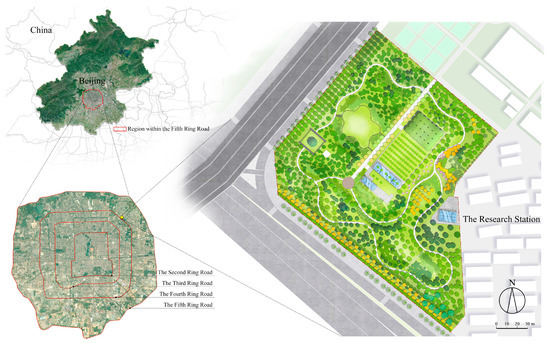
Figure 1.
Regions within the Fifth Ring Road and the first National Level Scientific Observation and Research Station for the Urban Green Space Ecosystem in Beijing.
3. Methodology
3.1. Sample Point Selection and Data Collection
We randomly selected 45 sampling points within the research station. Sampling points were located in three plant communities: broad-leaved forest, coniferous forest, and coniferous/broad-leaved-mixed forest. The locations of sampling points were surrounded by the majority of tree species in the study area. From the center of each point, forty-five 1 m2 sampling squares were established for litterfall collection (Figure 2). Locations for sampling squares were representative of the plant community; surrounded by healthy trees; located more than 5 m from rivers, roads, or cut survey lines; and reflective of the general litterfall composition of the community.
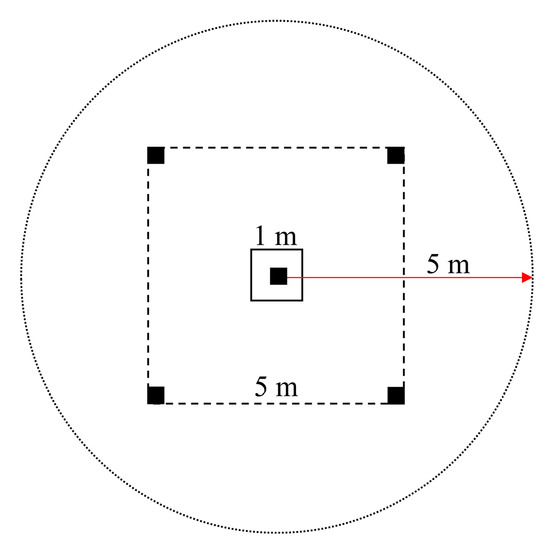
Figure 2.
Schematic diagram of litterfall sampling points and survey circles. White square represents the sampling square for litterfall collection. Black rectangle represents the leaf area index (LAI) measurement point.
A survey circle of radius 5 m was centered on the sampling point. All trees within the circle were tallied. Shrubs greater than 3 m tall were treated as trees [28]. For all trees within the circle, we recorded diameter at breast height (DBH) (1.3 m above soil level, accuracy of 0.1 cm), tree height, crown width, and crown length (all measured to the closest 0.1 m) in summer. The survey circles usually contained 2–5 trees (Figure 3). The total population of 45 survey circles included 131 trees of 23 species. These included 103 trees from 19 broad-leaved species, accounting for 78.63% of the total, and 28 trees from four coniferous tree species, accounting for 21.37% of the total. All of these trees were common urban greening species planted in Beijing.
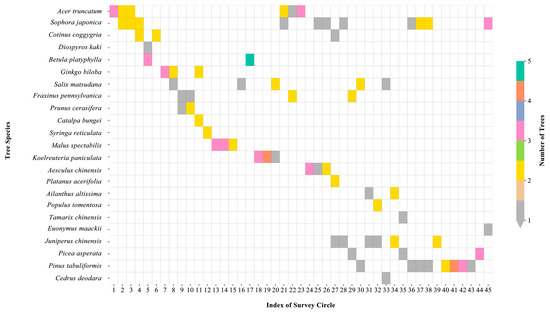
Figure 3.
Composition of tree species in the 45 survey circles.
Sophora japonica (17.48%) and Acer truncatum (12.62%) account for a large proportion of the total broad-leaved tree species. Pinus tabuliformis was the most numerous conifer, accounting for 50% of the conifer stems. Nine survey circles (20% of the total) contained a single tree species, while thirty-six survey circles contained two or more species. Twenty-six survey circles (57.78% of the total) contained only broad-leaved species, seven circles (15.56%) contained only conifers, and twelve survey circles (26.66%) contained both broad-leaves trees and conifers.
A plant-canopy analyzer (Model: Li Cor LAI-2200C; Li Cor Inc., Lincoln, NB, USA) was used to measure the leaf area index (LAI) at each sampling point in August, when the branches and leaves were most luxuriant. The LAI measurements were usually made on cloudless sunny mornings under scattered light conditions and care was taken to avoid direct sunlight on the sensor. A 5 × 5 m square was established with the sampling point at the center. The A reading was taken under a clear blue sky, and five B readings were taken at the sampling square center and at the four corners of the square [29]. The LAI of each sampling point was then calculated automatically based on the A and B readings made by the analyzer.
3.2. Determination of the Biomass and Carbon Ratio of Litterfall
All remaining litterfall accumulated before 2021 was removed from the sampling squares. From 2021 to 2022, litterfall was collected at a fixed time each month during the autumn defoliation. It was collected manually and placed in self-sealing bags [30]. After removing non-litterfall material, including gravel and mud, litterfall samples were dried and weighed to obtain samples of litterfall biomass, and the cumulative total biomass of the experimental year was calculated. This value represented the annual litterfall biomass.
Dried samples were uniformly and thoroughly mixed, crushed with a grinder, and passed through a 100-mesh sieve (with a pore size of 0.15 mm). Approximately one quarter of each litterfall sample was separated out, and four 30 g test samples were taken for further testing. A Thermo Scientific FlashSmart Element Analyzer was used to measure the C ratio through the Eagle Smart workstation using the high-temperature combustion method [31]. This procedure was repeated three times for each test sample, and the average was taken as the litterfall sample C ratio. The litterfall carbon density (LCD) was calculated using the sample biomass and C ratio.
3.3. Structural Index Calculation and Proxy Indicators Screening
The structural indices in Table 1 were calculated based on the tally results in the survey circles. Linear correlations between these indices and the litterfall biomass, C ratio, and C density were calculated. We also performed a stepwise multiple linear regression using LCD as the dependent variable and the structural indices as independent variables. Collinearity checks and semantic repeatability screening were performed on the retained influential variables to ensure the validity of the analysis. This process helped to determine a final set of proxy indicators.

Table 1.
Structural indices calculated in the study.
3.4. Satellite-Remote-Sensing-Data Inversion and Estimation of Annual Litterfall Carbon Storage in Urban Green Spaces
Remote sensing data from the Sentinel-2 satellite was used to estimate the annual litterfall C storage in urban green spaces in regions within the Fifth Ring Road. After orthophoto correction and subpixel-level geometric precision correction, the multispectral L1C level product was selected. Visual interpretation was used to determine the vector boundaries of the major roads in Beijing, including the Fifth Ring Road, Fourth Ring Road, Third Ring Road, and Second Ring Road. Then, the multispectral images were cropped. Using infrared (IR) and near-infrared (NIR) spectral data, the NDVI within the Fifth Ring Road in Beijing was calculated using Formula 1. The NDVI is commonly used as a measure of vegetation growth status and cover and is suitable for large-scale observations of vegetation dynamics [32]. The value of the NDVI ranges from −1 to +1, with negative values indicating water, clouds, and snow; 0 indicating rocks or bare land; and positive values indicating vegetation cover.
Measurements of the NDVI from satellite data have often been used to estimate the distribution of the LAI over large areas [33,34,35]. However, urban green spaces are usually separated by roads. Urban green space is, therefore, a network landscape composed of multiple patches with higher spatial heterogeneity than forest landscapes. It is, therefore, difficult to directly apply empirical formulas for crops [36] or forests [37] to urban green spaces. We, therefore, used the LAI inversion model of Liu [38] for urban green space at a resolution of 50 m (Formula (2)) to demonstrate the application of satellite remote sensing data to the inversion and estimated the litterfall C pool in urban-green-space litter.
4. Results
4.1. Distribution of Trees and Litterfall in Different Types of Sampling Units
Figure 4 illustrates the distribution characteristics of LAI, the sum of DBH measurements of trees within the circle (SDBH) (in cm), the sum of crown width measurements of trees within the circle (SCW) (in m), and the sum of crown volume measurements of trees within the circle (SCV) (in m3) in the three types of sampling unit. A one-way analysis of variance (ANOVA) revealed significant differences among the three types of sampling unit. The highest LAI values (3.40) were recorded in broad-leaved units, followed by coniferous/broad-leaved mixed units (2.96) and coniferous units (2.17). These findings were consistent with those of previous studies, suggesting that conifers had lower LAI values than broad-leaved trees [39].
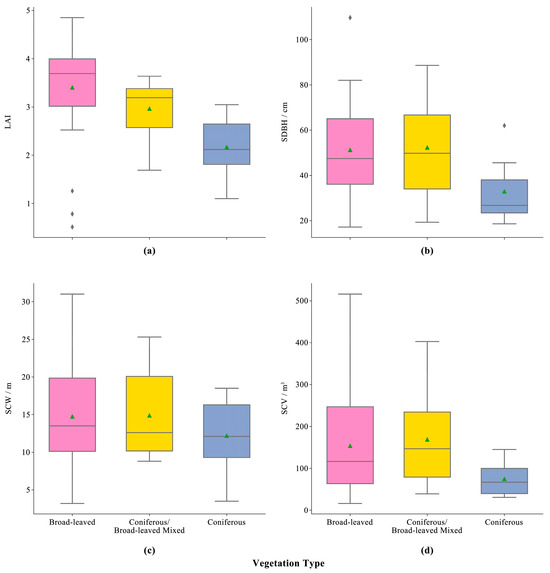
Figure 4.
(a) Distribution characteristics of the LAI, (b) the sum of the diameter at breast height (DBH) measurements of trees within the circle (SDBH), (c) the sum of crown width measurements of trees within the circle (SCW), and (d) the sum of crown volume measurements of trees within the circle (SCV) in broad-leaved, coniferous, and coniferous/broad-leaved mixed units. The rhombus represents quilters, and the triangles represents the mean of data.
The diameters of trees within the survey circles were characterized by SDBH. The SDBH distribution of broad-leaved (51.26 cm) and coniferous/broad-leaved-mixed units (52.31 cm) were similar. In contrast, the coniferous units had significantly smaller values of SDBH. This may be attributed to the slow growth rates among conifers, which may be due to their small leaves, low photosynthesis rate, and slow rates of organic-matter transport and transformation. Under similar growth conditions in forests of a similar age, the DBH growth rate is faster for broad-leaved trees than conifers.
The crown widths of trees in the sampling circles were also investigated. The broad-leaved units supported a wider range of SCW than the coniferous/broad-leaved mixed or coniferous sampling units. Coniferous units had the narrowest range of SCW. However, the average SCW of the three types of units were statistically similar. The average SCV of broad-leaved and coniferous/broad-leaved mixed units were similar to those of the coniferous unit. These findings suggest that the crown volume of trees in the different types of units were relatively stable.
Litterfall C ratios were relatively consistent across all sampling units and ranged from 43.69% to 46.65% (Figure 5). A one-way ANOVA revealed no significant differences in the distribution of the litterfall C ratio among the three types of sampling units. However, because litterfall was collected monthly, and thermal deactivation of enzymes occurred immediately, the decompositional release of stocking C was likely to be minimal at this stage. The litterfall C ratio (41.23%) in this study was slightly higher than the average litterfall C ratio in a forest site (36.38%) in Wang et al. [40]. The distribution of the C density in sampling units varied significantly due to the differences in the dry weight of litterfall samples. The minimum C density (35 g·m−2) occurred in broad-leaved units, while the maximum C density (360.77 g·m−2) was recorded in coniferous/broad-leaved mixed units. The average C density in the broad-leaved units (148.70 g·m−2) was only 62.1% of the density in coniferous/broad-leaved-mixed units (239.44 g·m−2) and 58.27% of that in coniferous units (255.19 g·m−2).
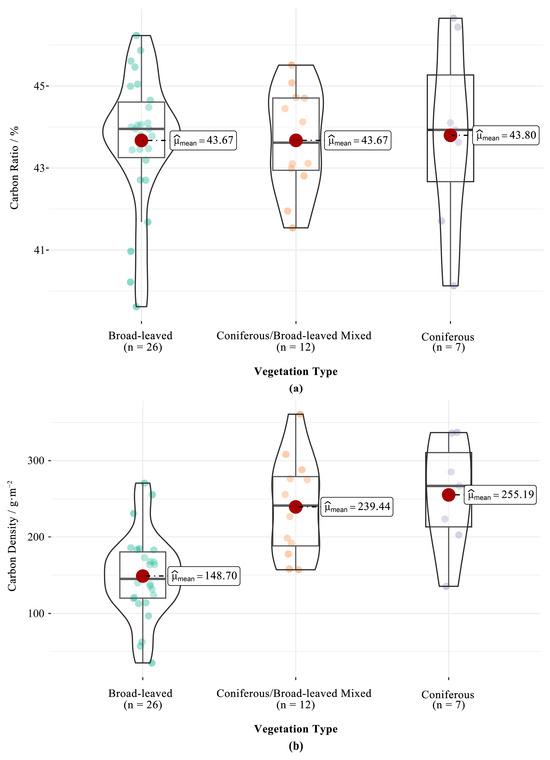
Figure 5.
(a) The carbon ratio and (b) carbon density of litterfall in broad-leaved, coniferous, and coniferous/broad-leaved-mixed sample units.
4.2. Screening of Proxy Indicators
The correlations among indices are shown in Figure 6. The LAI, SDBH, SCW, and SCV distributions appeared to follow approximately normal distributions. The peaks and centers of LAI distributions were significantly different among vegetation types. The peak and center of SDBH in the coniferous unit were significantly different from those of the other vegetation types. The peaks and centers of crown width and crown volume were similar across all three unit types. Below the diagonal, the correlation coefficients among proxy indicators, separated by vegetation type, were all greater than 0.475. Above the diagonal, the correlations among indicators for the pooled population of sampling units were all statistically significant (r > 0.554, p < 0.01).
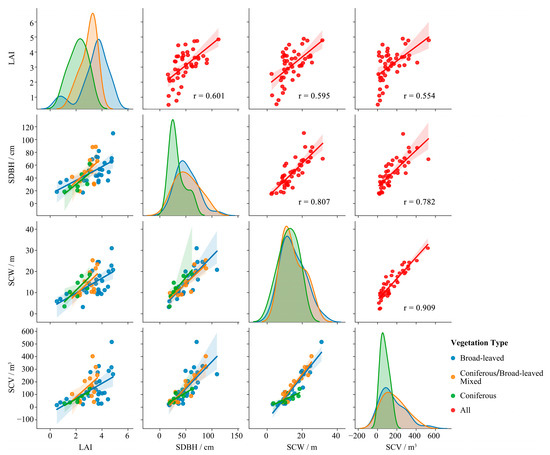
Figure 6.
Correlations among indices. The figures on the diagonal are the distribution curves of LAI, SDBH, SCW, and SCV in the different types of sampling units. Below the diagonal are correlation scatter plots of the four indicators separated by vegetation type. Above the diagonal are correlation scatter plots for the four indicators in the pooled population of sampling units.
A stepwise regression was carried out to distinguish sampling units. The regression model used the natural logarithm of C density as the dependent variable and the indices in Table 1 as independent variables. The CE, CP, and SCV were removed, and the LAI, SDBH, and SCW were selected for a collinearity check and semantic repeatability screening. When combined with the results of the correlation analysis, the stepwise regression supported the selection of LAI as the most useful proxy indicator.
Subsequently, log-linear regressions were performed with C density as the dependent variable and LAI as the independent variable. The results showed that LAI could explain 70.6% of the variance in C density in broad-leaved units (all p < 0.05), 54.5% of C-density variance in coniferous/broad-leaved mixed units, and 62.3% of variance in coniferous units (Table 2, Figure 7). A log-linear regression was also performed on the pooled population of sampling units, but due to differences in linear relationships and the wide scatter of data among types of sampling units, the regression captured a relatively low but significant (p < 0.01) 15.9% of C-density variance.

Table 2.
Results of log-linear regressions between LAI and carbon density.
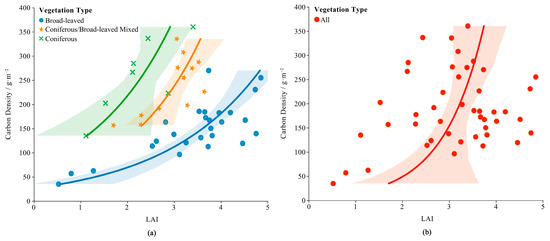
Figure 7.
Logarithmic linear regressions with carbon density as the dependent variable and LAI as the independent variable. (a) Regressions separated by vegetation type; (b) regression on the pooled population of sampling units.
4.3. Estimation of Litterfall Carbon Density in Urban Green Spaces within the Fifth Ring Road
We combined remote sensing data with the results of log-linear regression on the pooled population of sampling units to estimate LCD in urban green spaces in the region within the Fifth Ring Road of Beijing. As shown in Figure 8, the regional vegetation coverage was greater than 30% (NDVI > 0.21) [41,42] and accounted for 25.28% of the total area. The average NDVI of regions within the Fifth Ring Road was 0.30, indicating a relatively high rate of urban greening. In particular, there was a large area of green space in the region between the Fourth and Fifth Ring Roads. The maximum NDVI (0.86) was recorded in this region.
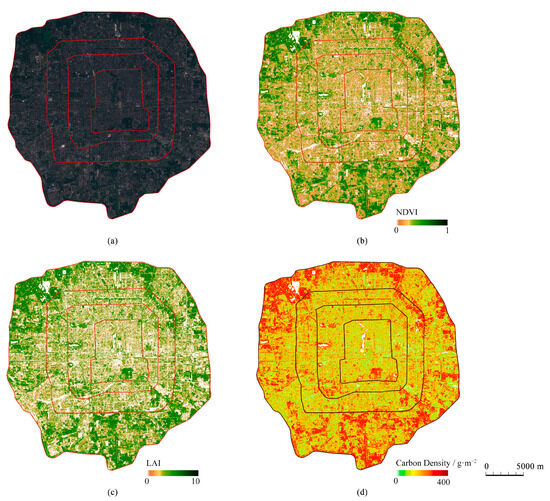
Figure 8.
Estimation of the litterfall carbon density in regions within the Fifth Ring Road of Beijing. (a) Satellite imagery of regions within the Fifth Ring Road. (b) Normalized difference vegetation index (NDVI) values, (c) estimated LAI, and (d) estimated carbon density in regions within the Fifth Ring Road.
The regional distribution of LAI was highly correlated with NDVI. The LAI of most green areas in regions within the Fourth Ring Road was lower than 2.00, but the LAI of the green spaces in the region between the Fourth and Fifth Ring Roads reached a maximum value of 7.21. The regional distribution of LCD corresponded to that of the LAI. The LCDs were generally lower than 150 g·m−2 in green spaces in the region within the Fourth Ring Road, but were greater than 250 g·m−2 in the region between the Fourth and Fifth Ring Roads, and the maximum estimated value was 364.34 g·m−2.
Regional litterfall C storage was estimated from 2015 to 2021 using satellite imagery in August (Figure 9). Estimates were prepared for the regions within the Second Ring Road, between the Second and Third Ring Roads, between the Third and Fourth Ring Roads, and between the Fourth and Fifth Ring Roads. The litterfall C storage followed the order of region within the Second Ring Road < region between the Second and Third Ring Roads < region between the Third and Fourth Ring Roads < region between the Fourth and Fifth Ring Roads. Litterfall C storage in the region between the Fourth and Fifth Ring Roads accounted for 59% of the total litterfall C storage in the region within the Fifth Ring Road, which was about 1.44 times the total litterfall C storage in the region within the Fourth Ring Road.
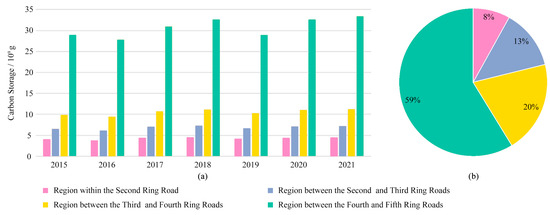
Figure 9.
(a) Estimated annual litterfall carbon storage in each region between 2015 and 2021. (b) Proportion of estimated annual litterfall carbon storage in each region.
We used the formula in Yin et al. [43], who used the NDVI to estimate the C storage of urban green spaces, to estimate the total C storage of urban green spaces in regions within the Fifth Ring Road from 2015 to 2021 (Figure 10). From 2015 to 2017, annual litterfall C storage in regions within the Fifth Ring Road fell into the range 4.5–5.8 × 1010 g and displayed a fluctuating but increasing trend. After 2018, the annual litterfall C storage stabilized. The total C storage of green spaces in 2016 was about 18 × 1010 g, while in 2018, 2020, and 2021 it was >28 × 1010 g. Annual litterfall C storage accounted for 18% to 25% of the total C storage of green spaces, with no significant trends recorded.
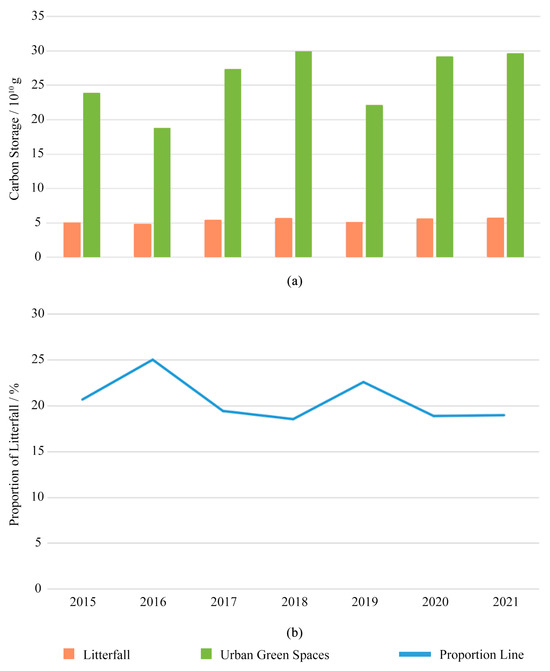
Figure 10.
(a) Estimated annual litterfall carbon storage and estimated total carbon storage, and (b) ratio of estimated annual litterfall carbon storage to total carbon storage in green spaces in regions within the Fifth Ring Road from 2015 to 2021.
5. Discussion
5.1. Differences in Litterfall Carbon Storage among Tree Species with Different Traits
Litterfall is an important management issue in urban green spaces. To a certain extent, litterfall production reflects primary productivity in urban green space [44], and is a concrete manifestation of C storage in these spaces. The biomass of litterfall was proportional to the total basal area of trees within a distance of 10–30 m [45]. In this study, the average litterfall biomass per unit area in broad-leaved units was only about 60% of the litterfall biomass in coniferous/broad-leaved-mixed units and coniferous units. This might be related to the crown width and leaf shape of different tree species. In broad-leaved units, there were 19 tree species. The crowns of tall trees such as Populus tomentosa, Styphnolobium japonicum, and Acer truncatum are large, and they distribute litterfall across a large area. In particular, paper-leaf tree species such as Styphnolobium japonicum are strongly affected by wind, and their leaf litterfall is distributed across a large area, resulting in a small litterfall biomass per unit area. Similarly, in the conifer units and conifer/broad-leaved-mixed units, conifers such as Pinus tabulaeformis and Juniperus chinensis have a small vertical projection area that is close to the ground. The surfaces of conifer needles are covered with a waxy layer, their mass density is high, and their leaves are narrow and not easily caught by the wind. The range over which conifer litterfall is dispersed is, therefore, relatively restricted. The cones of coniferous trees also mature and fall in late autumn. The water content in cones is low, which increases the biomass of litterfall per unit area in coniferous and coniferous/broad-leaved mixed units. Because the C ratio varies little (Figure 5), the biomass per unit area determines the carbon stocking capability of tree species. Therefore, for comparable crown projection areas, the carbon stocking capability of the conifers was higher than that of broad-leaved trees.
5.2. The LAI Can Be Used as a Proxy Indicator of Litterfall Carbon Density in Urban Green Space
The direct-measurement method is one of the most commonly used and accurate methods to determine the carbon stocking capability of litterfall in urban green spaces. However, to ensure that the data gathered are representative of an area, large-scale random sampling is needed. Precision experimental instruments and tools must then be used to determine the biomass and organic C ratio of the samples. Due to its labor-intensive nature and economic cost, the direct-measurement method is only suitable for measuring relatively small areas of urban green space.
In this study, we developed a method to estimate the LCD in urban green spaces using a proxy indicator, which can greatly simplify the estimation procedure and reduce the cost of sampling. Based on the survey data of typical plots, we used a multivariate stepwise regression to identify LAI as a suitable proxy indicator for estimating LCD. The procedure for measuring the LAI of urban green space is relatively simple. It can be directly measured using handheld instruments or estimated from remote sensing data, and the accuracy is relatively high when it is estimated across a large area. Previous studies have determined that litterfall C storage is closely related to tree biomass. The LAI was significantly correlated with SDBH and SCW, which are variables that can reflect the growth status of tree crowns [46]. Moreover, the LAI was positively correlated with litterfall biomass, and the larger the LAI, the higher the biomass yield of the litterfall [29].
In this study, however, similar litterfall C ratios were recorded across different types of sampling units, and the differences within sampling units were relatively small. Therefore, the LAI can be used as a proxy indicator for LCD and can be used to indirectly estimate the annual litterfall C pool in urban green spaces.
5.3. Underestimation of the Litterfall Carbon Pool in Urban Green Space
There is a paucity of research on the litterfall C pool in urban green space. Furthermore, litterfall C storage has often been neglected in studies of urban green space [47]. In forest ecosystems, the litterfall C pool is often studied as part of the total forest C pool. Pan et al. [48] and Mandal et al. [49] reported that the litterfall C pool accounts for about 5% of the overall forest C pool. However, the litterfall in forest ecosystems has accumulated over long periods of time and is continuously decomposed by microorganisms. Most of the organic matter is decomposed and re-released back to the atmosphere as CO2 and some enters the soil C pool.
Litterfall is regularly collected in urban green spaces, and, therefore, the conditions for litterfall accumulation and decomposition remain unfulfilled. As reported by Wang et al. [50], the biomass of branches and leaves for the major evergreen trees in Beijing accounted for about 40.8% of the total biomass per tree, and the biomass of branches and leaves of deciduous trees accounted for 23.7% of the total biomass per tree. The C ratio of leaves and branches was also higher than the average C ratio of the whole plant. Using the formula in Yin et al. [43] to estimate C storage based on the NDVI, the total C storage of plants in regions within the Fifth Ring Road of Beijing in August 2021 was calculated to be 29.6 × 1010 g. The annual litterfall C storage estimated using the same technique was calculated to be 5.6 × 1010 g (Figure 10). Therefore, the annual litterfall C storage accounted for 18.9% of the total C storage in the urban green space in Beijing, which was far more than that observed in forest ecosystems.
Based on our results, we simplistically speculated that when an urban tree reaches 15 years of age, the cumulative litterfall C storage over its lifetime was 2.83 times the net C storage of the living tree (18.9% × 15 = 2.83). We, therefore, concluded that the litterfall C pool in urban green space is seriously underestimated. Litterfall C exists in the form of organic matter, which is convenient for resource utilization. The correct estimation and exploitation of litterfall will provide a basis for validating the role of litterfall in C stocking and emission reduction.
5.4. The Accuracy of Litterfall-Carbon-Density Inversion Using Remote Sensing Images Needs to Be Further Improved
In this study, a typical urban green space in Beijing was used as research subject to facilitate the screening of proxy indices for LCD in urban green spaces. We explored the feasibility of using the LAI to estimate the litterfall C pool in large urban green spaces. A typical urban green space is mainly composed of parkland, attached green space, and regional green space, but other categories of urban green space exist. The parameters of the log-linear regression model do not have universal adaptability and the model cannot be applied to all types of green spaces. To achieve comprehensive coverage of all types of urban green space, a strategy of increasing the number of sampling points and preparing separate models for each vegetation type may achieve some improvements in the inversion accuracy.
Compared to traditional LAI measuring methods, LAI inversion using high-resolution satellite images has the advantages of achieving wide coverage, high temporal and spatial resolution, and relatively low experimental cost [38]. However, urban green spaces are affected by the road distribution, and are subdivided into many discrete patches with high heterogeneity and fragmentation. Scale effects may cause inversion errors, and relatively few studies have been conducted in which the LAI in urban green space has been measured using remote-sensing-image inversion. There is no LAI inversion model suitable for Beijing urban green spaces. Like Beijing, Wuhan is a megacity in China. We, therefore, drew on the LAI inversion model of Liu [38] to estimate data for the urban green space in Beijing. This model may have introduced measurement biases into the C-density estimation. It is, therefore, important to establish an LAI inversion model developed specifically for use in the urban green space of Beijing to improve the estimation accuracy of litterfall C storage.
6. Conclusions and Prospects
Based on 45 sampling units in typical urban green spaces in Beijing, we selected LAI as an effective proxy indicator for LCD estimation, and established a rapid and relatively accurate log-linear regression model between LAI and LCD for estimating the annual litterfall C pool in urban green spaces. We used Sentinel-2 satellite images to invert the total C pool and annual litterfall C pool in urban green spaces in regions within the Fifth Ring Road. The results showed that the annual litterfall C pool in urban green spaces was approximately 18.9% of its total C pool, which was larger than that measured in forest ecosystems. Therefore, we concluded that the C stocking capability of litterfall was seriously underestimated.
This study revealed the significance of litterfall in reducing C emissions, which may be of interest for policy-makers. Moreover, our findings’ results promote the development of litterfall resource utilization, and are anticipated to accelerate the institutionalization and standardization of litterfall management and utilization methods to achieve the goals of carbon peaking and carbon neutrality.
Author Contributions
Conceptualization, Y.C.; data curation, Y.C.; formal analysis, Y.C.; investigation, Y.C. and Y.Q.; methodology, Y.C.; project administration, Y.C., X.L. and Y.L.; resources, J.G. and X.L.; software, Y.C.; supervision, X.L.; validation, Y.C.; writing—original draft, Y.C.; writing—review and editing, Y.C. All authors have read and agreed to the published version of the manuscript.
Funding
This research was funded by the Study on Comprehensive Carbon Stocking Capability of Urban Green Space Plant Community and Its Influencing Factors (funding number STBH202301), and the Study on Optimization of Ecological Benefit Evaluation System of Urban Green Space in Beijing and Its Influence Mechanism on Residents’ Well-being (funding number STZD202301).
Data Availability Statement
The data presented in this study are available on request from the corresponding author. The data are not publicly available due to confidentiality.
Acknowledgments
Special thanks to Deyong Yu of Beijing Normal University who helped supporting and guidance the study.
Conflicts of Interest
The authors declare no conflict of interest.
References
- Hobbie, S.E.; Grimm, N.B. Nature-based approaches to managing climate change impacts in cities. Philos. Trans. R. Soc. B 2020, 375, 20190124. [Google Scholar] [CrossRef]
- Chai, Q.M. Research on China’s pathways to achieve carbon peaking and carbon neutrality goals. Chin. J. Urban Environ. Stud. 2022, 10, 2250007. [Google Scholar] [CrossRef]
- Zhao, D.; Cai, J.; Xu, Y.M.; Liu, Y.H.; Yao, M.M. Carbon sinks in urban public green spaces under carbon neutrality: A bibliometric analysis and systematic literature review. Urban For. Urban Green. 2023, 86, 128037. [Google Scholar] [CrossRef]
- Zhang, Z.R.; Gao, X.X.; Zhang, S.B.; Gao, H.; Huang, J.; Sun, S.Y.; Song, X.F.; Fry, E.; Tian, H.Q.; Xia, X.H. Urban development enhances soil organic carbon storage through increasing urban vegetation. J. Environ. Manag. 2022, 312, 114922. [Google Scholar] [CrossRef] [PubMed]
- Thomas, S.C.; Malczewski, G.; Saprunoff, M. Assessing the potential of native tree species for carbon sequestration forestry in Northeast China. J. Environ. Manag. 2007, 85, 663–671. [Google Scholar] [CrossRef] [PubMed]
- Ma, X.T.; Yan, T.H.; Qin, Y.Y.; Wang, H.L.; Yan, Y.F. Optimization of green space plant configuration in residential areas of Chongqing central business district based on green plot ratio: A case study of Xuhui city residential community. J. Geosci. Environ. Protect. 2023, 11, 37–49. [Google Scholar] [CrossRef]
- Turner, D.P.; Koerper, G.J.; Harmon, M.E.; Lee, J.J. A carbon budget for forests of the conterminous United States. Ecol. Appl. 1995, 5, 421–436. [Google Scholar] [CrossRef]
- Horodecki, P.; Jagodziński, A.M. Site type effect on litter decomposition rates: A three-year comparison of decomposition process between spoil heap and forest sites. Forests 2019, 10, 353. [Google Scholar] [CrossRef]
- Hillier, J.; Whittaker, C.; Dailey, G.; Aylott, M.; Casella, E.; Richter, G.M.; Riche, A.; Murphy, R.; Taylor, G.; Smith, P. Greenhouse gas emissions from four bioenergy crops in England and Wales: Integrating spatial estimates of yield and soil carbon balance in life cycle analyses. Gcb Bioenergy 2009, 1, 267–281. [Google Scholar] [CrossRef]
- Vargas-Soplín, A.J.; Prochnow, A.; Herrmann, C.; Tscheuschner, B.; Kreidenweis, U. The potential for biogas production from autumn tree leaves to supply energy and reduce greenhouse gas emissions: A case study from the city of Berlin. Resour. Conserv. Recycl. 2022, 187, 106598. [Google Scholar] [CrossRef]
- Wei, Z.Q.; Cheng, Z.Q.; Shen, Y.F. Recent development in production of pellet fuels from biomass and polyethylene (PE) wastes. Fuel 2024, 358, 130222. [Google Scholar] [CrossRef]
- Zhang, J.M.; Chen, M.; Zhu, M.Y.; Yu, W.W.; Yao, J.C.; Xu, X.Y.; Ren, X.Q. Research on composting and substrate utilization of garden waste. Agr. Biotech. 2021, 10, 104–107,112. [Google Scholar]
- Shukla, S.; Waghe, K.; Singh, S. Production of organic fertilizer from garden waste. J. Emerg. Technol. Innov. Res. 2019, 6, 240–243. [Google Scholar]
- Beedie, D. A Method for the Production of Charcoaland the Generation of Power via the Pyrolysis of Biomass Material. Application Number GB19990016480, 20 November 2022. [Google Scholar]
- Xu, Z.C.; Ma, Y.; Zhang, L.X.; Han, Y.Y.; Yuan, J.; Li, G.X.; Luo, W.H. Relating bacterial dynamics and functions to gaseous emissions during composting of kitchen and garden wastes. Sci. Total Environ. 2021, 767, 144210. [Google Scholar] [CrossRef] [PubMed]
- Yu, Y.Y.; Jia, C.R.; Wu, C.L.; Chen, Q.Y.; Zhu, B.G. Research progress on compost utilization of garden waste. Mod. Hortic. 2022, 45, 47–48,58,154. [Google Scholar]
- Qu, B.; Sun, X.; Li, S.; Zhang, H.; Wang, X.; Xiong, K.; Yun, B. Manufacturing process and hydrological characteristics of ecological mulching mats made from green waste. J. Beijing For. Univ. 2018, 40, 77–85. [Google Scholar] [CrossRef]
- Li, Y.F.; Wang, Z.J.; Shi, W.L.; Yang, H.T. Litter quality modifies soil organic carbon mineralization in an ecological restoration area. Land Degrad. Dev. 2023, 34, 1806–1819. [Google Scholar] [CrossRef]
- Wei, Y.Q.; Zhang, Y.J.; Wilson, G.W.T.; Guo, Y.F.; Bi, Y.X.; Xiong, X.; Liu, N. Transformation of litter carbon to stable soil organic matter is facilitated by ungulate trampling. Geoderma 2021, 385, 114828. [Google Scholar] [CrossRef]
- Wu, F.Z.; Xu, Z.F.; Yang, W.Q. Carbon and nutrient transfer via above- and below-ground litter in forests. Forests 2022, 13, 2176. [Google Scholar] [CrossRef]
- Castellanos-Barliza, J.; León-Peláez, J.D.; Armenta-Martínez, R.; Barranco-Pérez, W.; Caicedo-Ruíz, W. Contributions of organic matter and nutrients via leaf litter in an urban tropical dry forest fragment. Rev. Biol. Trop. 2018, 66, 571–585. [Google Scholar] [CrossRef]
- Ridgeway, J.R.; Morrissey, E.M.; Brzostek, E.R. Plant litter traits control microbial decomposition and drive soil carbon stabilization. Soil Biol. Biochem. 2022, 175, 108857. [Google Scholar] [CrossRef]
- Li, Y.; Liu, X.J.; Xu, W.B.; Bongers, F.J.; Bao, W.K.; Chen, B.; Chen, G.K.; Guo, K.; Lai, J.S.; Lin, D.M.; et al. Effects of diversity, climate and litter on soil organic carbon storage in subtropical forests. For. Ecol. Manag. 2020, 476, 118479. [Google Scholar] [CrossRef]
- Guo, Y.; Chen, H.Y.H.; Mallik, A.U.; Wang, B.; Li, D.; Xiang, W.; Li, X. Predominance of abiotic drivers in the relationship between species diversity and litterfall production in a tropical karst seasonal rainforest. For. Ecol. Manag. 2019, 449, 117452. [Google Scholar] [CrossRef]
- Schlesinger, W.H. Biogeochemistry: An Analysis of Global Change; Academic Press: Oxford, UK, 1991. [Google Scholar]
- Templer, P.H.; Toll, J.W.; Hutyra, L.R.; Raciti, S.M. Nitrogen and carbon export from urban areas through removal and export of litterfall. Environ. Pollut. 2015, 197, 256–261. [Google Scholar] [CrossRef]
- Li, S.D.; Wang, C.; Sun, Z.K. Spatial layout of urban ecosystem positioning observation and research station in China. J. Chin. Urban For. 2023, 21, 52–59. [Google Scholar] [CrossRef]
- Yin, Z.; Zhang, Y.X.; Zhang, R.; Chen, G.J.; Cong, Y.P.; Ma, K.M. Structure of an urban green space indirectly affects the distribution of airborne particulate matter: A study based on structural equation modelling. Urban For. Urban Green. 2022, 72, 127581. [Google Scholar] [CrossRef]
- Behera, S.K.; Behera, M.D.; Tuli, R. An indirect method of estimating leaf area index in a tropical deciduous forest of India. Ecol. Indic. 2015, 58, 356–364. [Google Scholar] [CrossRef]
- Hughes, J.W.; Fahey, T.J.; Browne, B. A better seed and litter trap. Can. J. For. Res. 1987, 17, 1623–1624. [Google Scholar] [CrossRef]
- Qian, J.G.; Mopper, K. Automated high-performance, high-temperature combustion total organic carbon analyzer. Anal. Chem. 1996, 68, 3090–3097. [Google Scholar] [CrossRef]
- Becker, F.; Choudhury, B.J. Relative sensitivity of normalized difference vegetation Index (NDVI) and microwave polarization difference Index (MPDI) for vegetation and desertification monitoring. Remote Sens. Environ. 1988, 24, 297–311. [Google Scholar] [CrossRef]
- Chen, J.M. Remote sensing of leaf area index and clumping index. In Comprehensive Remote Sensing; Liang, S., Ed.; Elsevier: Oxford, UK, 2018; pp. 53–77. [Google Scholar]
- Jochem, V.; Gustau, C.V.; Jordi, M.M.; Pablo, R.J.; Frank, V.; Jan, G.P.W.C.; José, M. Optical remote sensing and the retrieval of terrestrial vegetation bio-geophysical properties—A review. ISPRS J. Photogramm. 2015, 108, 273–290. [Google Scholar] [CrossRef]
- Zheng, G.; Moskal, L.M. Retrieving leaf area index (LAI) using remote sensing: Theories, methods and sensors. Sensors 2009, 9, 2719–2745. [Google Scholar] [CrossRef] [PubMed]
- Houborg, R.; Anderson, M.; Daughtry, C. Utility of an image-based canopy reflectance modeling tool for remote estimation of LAI and leaf chlorophyll content at the field scale. Remote Sens. Environ. 2009, 113, 259–274. [Google Scholar] [CrossRef]
- Kobayashi, H.; Suzuki, R.; Kobayashi, S. Reflectance seasonality and its relation to the canopy leaf area index in an eastern Siberian larch forest: Multi-satellite data and radiative transfer analyses. Remote Sens. Environ. 2007, 106, 238–252. [Google Scholar] [CrossRef]
- Liu, N. Study on Sample Area Scale Effect of Urban Vegetation LAI Retrieval Based on TM and SPOT6 Images. Master’s Thesis, Huazhong Agricultural University, Wuhan, China, 2016. [Google Scholar]
- Soudani, K.; François, C.; Maire, G.L.; Dantec, V.L.; Dufrêne, E. Comparative analysis of IKONOS, SPOT, and ETM+ data for leaf area index estimation in temperate coniferous and deciduous forest stands. Remote Sens. Environ. 2006, 102, 161–175. [Google Scholar] [CrossRef]
- Wang, P.C.; Xing, L.J.; Xiao, W.F.; Huang, Z.L.; Pan, L.; Zeng, L.X. Organic carbon density and storage of forest ecosystems in Three Gorges Reservoir Area. Acta Ecol. Sin. 2009, 29, 97–107. [Google Scholar]
- Purevdorj, T.S.; Tateishi, R.; Ishiyama, T.; Honda, Y. Relationships between percent vegetation cover and vegetation indices. Int. J. Remote Sens. 1998, 19, 3519–3535. [Google Scholar] [CrossRef]
- Xi, Y.; Zhang, Z.Q.; Zhou, J.; Wang, L.Q.; Chen, L.X. Spatial and temporal variation of ground surface temperature under urbanization and its correlation with vegetation coverage: A case study of the 5th Ring Road of Beijing. Sci. Silvae Sin. 2021, 57, 1–13. [Google Scholar] [CrossRef]
- Yin, W.D.; Su, J.Y.; Xu, Z.Y.; Liu, Z.C. Urban green space carbon storage estimation based on remote sensing technology. Landsc. Archit. 2022, 29, 24–30. [Google Scholar]
- Tang, J.W.; Cao, M.; Zhang, J.H.; Li, M.H. Litterfall production, decomposition and nutrient use efficiency varies with tropical forest types in Xishuangbanna, SW China: A 10-year study. Plant Soil 2010, 335, 271–288. [Google Scholar] [CrossRef]
- Yuan, Z.Q.; Li, B.H.; Bai, X.J.; Lin, F.; Shi, S.; Ye, J.; Wang, C.G.; Hao, Z.Q. Composition and seasonal dynamics of litter falls in a broad-leaved Korean pine (Pinus koraiensis) mixed forest in Changbai Mountains, Northeast China. Chin. J. Appl. Ecol. 2010, 21, 2171–2178. [Google Scholar]
- Mathias, N.; Liisa, U.; James, J.; Sue, B.; Lars, V.; Radek, N.; Arne, V.; Lars, L.; Anne, T.; Panagiotis, M.; et al. Quantifying carbon and nutrient input from litterfall in European forests using field observations and modeling. Global Biogeochem. Cycles 2018, 32, 784–798. [Google Scholar] [CrossRef]
- Zhang, Z.J. Study on Carbon Potential and Its Cost-Benefit of Afforestation and Reforestation Activities in Guangxi, China. Ph.D. Thesis, Chinese Academy of Forestry, Beijing, China, 2009. [Google Scholar]
- Pan, Y.D.; Birdsey, R.A.; Fang, J.Y.; Houghton, R.; Kauppi, P.E.; Kurz, W.A.; Phillips, O.L.; Shvidenko, A.; Lewis, S.L.; Canadell, J.G.; et al. A large and persistent carbon sink in the world’s forests. Science 2011, 333, 988–993. [Google Scholar] [CrossRef]
- Mandal, S.; Chatterjee, P.; Das, N.; Banerjee, R.; Batabyal, S.; Gangopadhyay, S.; Mondal, A. Modelling the role of urban forest in the regulation of carbon balance in an industrial area of India. Acta Ecol. Sin. 2022, 42, 553–564. [Google Scholar] [CrossRef]
- Wang, D.S. Studies on Net Carbon Reserves in Beijing Urban Landscape Green Based on Biomass Measurement. Ph.D. Thesis, Beijing Forestry University, Beijing, China, 2010. [Google Scholar]
Disclaimer/Publisher’s Note: The statements, opinions and data contained in all publications are solely those of the individual author(s) and contributor(s) and not of MDPI and/or the editor(s). MDPI and/or the editor(s) disclaim responsibility for any injury to people or property resulting from any ideas, methods, instructions or products referred to in the content. |
© 2024 by the authors. Licensee MDPI, Basel, Switzerland. This article is an open access article distributed under the terms and conditions of the Creative Commons Attribution (CC BY) license (https://creativecommons.org/licenses/by/4.0/).